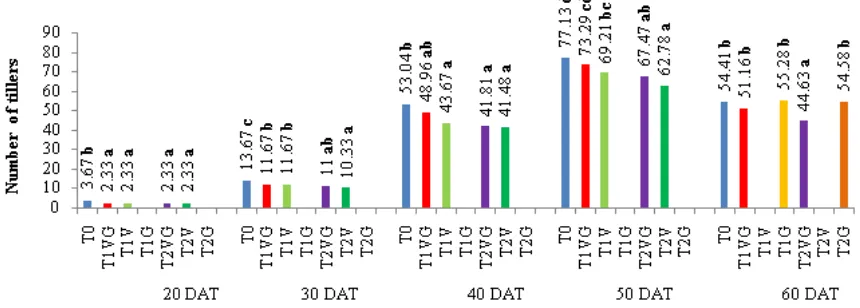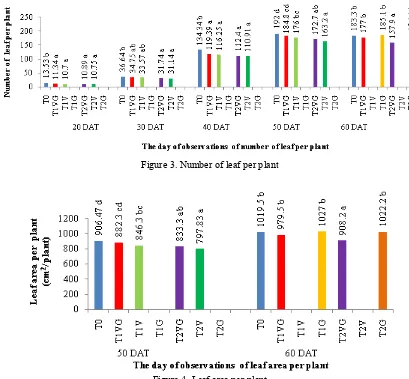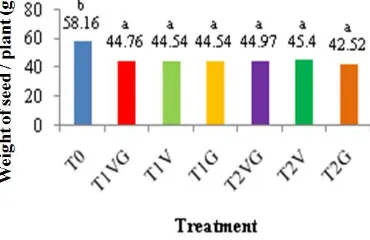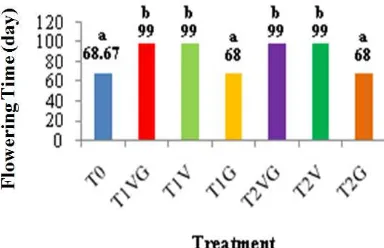ISSN: 2339-076X, Volume 3, Number 1 (October 2015): 469 - 475
DOI:10.15243/jdmlm.2015.031.469
Research Article
Simulation of increasing night temperature on vegetative and
generative of paddy (
Oryza sativa
L.)
D.F. Putra
1*, S.Y. Tyasmoro
1, K.P. Wicaksono
1, L. Vincie
21
Faculty of Agriculture, Brawijaya University, Jl. Veteran, Malang 65145, !ndonesia
2
BASF Asia Pasific Indonesia, Jalan Prof. Dr. Satrio Kav 3-5 Jakarta 12940, Indonesia
* corresponding author: [email protected]
Abstract :
The rate of respiration increases with increasing temperature. It causes a problem to occur with photosynthesis result (photosynthate) generated during photosynthesis as a source of energy for metabolism of plants. The objective of this study was to evaluate of growth and the production result by affected an increasing night temperature on paddy. The simulation was performed in growth chamber with increased night temperature by 20C (T1) and 40C (T2) higher than normal night temperature (T0). Growth phase of rice plant treated an increase in night temperature among others on the vegetative phases continues on the generative phase (VG), was treated only on the vegetative phase (V) and treated only on the generative phase (G). The number of tillers, leaf area, number of leaf, the total dry weight of rice plant on the T2 had values that were lower than at T0 and T1. The decreased values in the parameter number of tillers, leaf area, number of leaf, and total dry weight at the end of the observation were observed on T2V and T2 VG. The T2 had longer panicle than T1 and T0, but the number of panicle, weight of seed per plant, harvest index (HI), the number of productive tillers, flowering time, harvesting time , nitrogen content in the leaves, the and percentage of open stomata values were lower than T1 and T0. T1G, T1VG, T2VG and T2G showed lower percentage of full grain than at T0. T1 and T2 treatments on VG and V resulted in the delay of flowering time. T1 and T2 on the VG phase resulted in the delay of harvesting time.Keywords: generative, night temperature, vegetative
Introduction
In the current year and the next few years, due to global warming phenomenon, the increase in the greenhouse effect and air temperature become major factors affecting rice production. Projections of an increase in average air temperature globally at the end of the 21stcentury (1980-1999) are about 2-4oC (IPCC, 2007). Minimum temperature (night time) increases faster than the maximum temperature (day time) on the previous few years (Easterling et al., 1997). Research on the temperature of the night on rice plant into the area to take precedence. Especially at night, the rice plant undergoes respiration. Respiration is a plant’s effort to sustain its life cycle if faced with increased air temperature. An increase in respiration requires carbon fixation to
increase in air temperature, it will result in the loss of rice yield. Temperature is decisive factor of plant development.
The rice crop is a C3 type of plant species and is very fond of increasing rates of CO2
assimilation and end result of rice grain. However, some studies show that a high air temperature impact to the decline of the yield despite an enriched CO2 (Horie et al., 2000). Farrel et al.
Simulation of increasing night temperature on vegetative and generative of paddy
High temperatures can affect the reproductive or vegetative phase, i.e. the burning of leaves, aging of leaves, disability of roots growth, and affect to the seed ripening. Some research that is often done in connection with heat will be stressing the antagonistic process in plants. Stomata will be open to cool the leaves through the process of transpiration. However, when stressed by heat and then followed with drought, a plant cannot open its stomata, causing the temperature of leaves to remain high (Rizksky et al., 2002). At high temperatures, inactivation of enzyme increases over the activity of activation enzyme to support metabolism (Craft-Brander and Salvucci, 2000).
Plant growth in high temperatures requires greater heat tolerance on thylakloid membrane and photosynthesis enzymes so it can increase photosynthesis in high temperatures (Yamori et al., 2013). The larger leaf photosynthesis decreased at night temperature of 23oC compared temperatures on 14, 17 and 20oC (Prasad, 2008). Therefore, although the process of photosynthesis occurs in the morning and afternoon, but with an increase in temperature at night also gave an impact on the process of photosynthesis
.
The objective of this study was to evaluate of growth and the production result by affected an increasing night temperature on paddy.Materials and Methods
This study was carried out in farm laboratory, Jatikerto Village, Kecamatan Kromengan, Kabupaten Malang from October 2013 to January 2014. Jatikerto village has an altitude of 355 m above sea level. Pots were placed inside growth chamber for the plants treated with increased night temperature as their treatments. Tools used in this study were hoes, meter, scales, ovens, buckets, lamps 100 Watt, thermometer, leaf area meters, SPAD –502PLUS (Soil Plant Analysis Development), electron microscope. The materials used included rice seed of IR64 variety, urea fertilizer (200 kg/ha), SP-36 fertilizer (75 kg/ha) and KCl fertilizer (50 kg/ha). Urea was applied three times at 14 DAT (day after transplanting), 21 - 28 DAT and 30-40 DAT. SP-36 and KCl were applied the same time with application of urea at 14 DAT. Seven treatments, i.e. (1) without an increase in night temperature (T0). (2) 2o C increase in night temperature treated at vegetative phase and generative phase (T1 VG), (3) 2o C increase in night temperature treated at vegetative phase only (T1 V). (4) 2oC increase in night temperature treated on
generative phase only (T1 G), (5) 4oC increase in night temperature treated at vegetative phase and generative phase (T2 VG), (6) 4o C increase in night temperature treated at vegetative phase only (T2 V), and (7) 4oC increase in night temperature treated on phase only (T2 G) were arranged in a randomized block design. For 2o C and 4o C increase in night temperatures, the entire population was placed in growth chamber. For increasing 2oC, the treatment imposed was placed and assembled with 9 100-Watt-lamps. For increasing 4oC, the treatment imposed was placed and assembled with 12 100-Watt-lamps. Every lamp was supplied with hood cover and wrapped in black cloth. The growth chamber was opened at 6 a.m. until 6 p.m. After 6 p.m., the growth chamber was closed and light was turned on. Watering time was on 14-15 DAT, 29-30 DAT and 44-45 DAT. The other day, the soil was watered intermittently until 80 DAT. After 80 DAT, the soil was allowed to dry until harvesting time came. Weeding mechanism was done manually if there was a weed inside of the pot. Data obtained ware subjected to analysis of variance followed by LSD test to show the difference in F test
Results and Discussion
Rice plant growth parameters showed that at the end of the day of the observation, the level of greenness of leaf did not differ significantly in spite of increased night time temperature by 2oC and 4o C. Increasing night temperature for 2o C and 4oC at various phases of growth (VG, V and G) did not either give an impact on changes in the greenness level of leaf rice plant’s leaves (Figure 1). The greenness level of rice plant’s leaves represent of the amount of chlorophyll as the leaf photosynthetic agent.
Heat stress occurs at the time due to environmental change, then there will be adjustments to plant parts like leaves to face the pressure of the environment. Actions to counteract the environmental pressure are done by performing metabolism and structural adjustment (Yamanouchi et al., 2002). Heat stock proteins (HSP) is a stabilization factor when subjected to environmental pressure (Shah et al., 2011). Rapid accumulation of HSP on the organ that is experiencing sensitive give the role to protect the cell metabolism so that it can adapt when subjected to temperature increase (Wahid et al., 2007). The existence of HSP can help to resolve the high temperature stress by mean of a fixing photosynthesis system, distributing assimilate
efficient use of water and nutrients to the stability of the cell membrane (Wahid et al., 2007). When there is a stabilization factor and relief from the HSP to confront the pressure temperature, gradually, there will be an impact on the process of enzyme in plant metabolism. At high temperatures, enzyme in activation will increase over the activity of activation enzyme to support metabolism activities (Crafts-Brander and Salvucci, 2000). Decrease in the number of tillers of rice plant as a result of an increase in nighttime temperatures is caused by the distribution of photosynthate to elongation of stem cell is bigger than to increase the number of tillers of rice plant (Cheng et al., 2009).
Figure 2. Number of tillers
The average number of leaf, leaf area, and total dry weight due to the increased temperature by 2oC and 4oC declined in line with increase in
Simulation of increasing night temperature on vegetative and generative of paddy
temperature by 4o C that was treated on the VG and phase V resulted in the decrease of average number of leaves, leaf area and total dry weight of rice plant when compared at T0 and treatments of increased night temperature of 2oC. Rice plant at
the treatment of increased temperature of the night by 2oC experienced acclimation. Acclimation is an adjustment to compensate for the respiration rate of temperature change (Aktin, 2003).
Figure 3. Number of leaf per plant
Figure 4. Leaf area per plant
The total dry weight significantly decreased when the increased night time temperature was 4oC compared to the total dry weight on T0 and T1. The high temperatures can increase respiration but cause cell membrane to lose stability and potentially lower biomass (Peng et al., 2004). An increase in temperature of 27-32oC will increase the number of injuries of membrane on the leaves rice plant by 60% (Muhammed and Tarpley, 2009). The functional system of cell membrane is as a center of plant productivity and plant acclimation to high temperature (Muhammed and Tarpley, 2009). Respiration has an impact on plant’s growth rate as it forms energy for new
Figure 5. Total dry weight
The dectrease of pollination in high temperatures is also affected by hormonal balance during flowering, distribution of photosynthate, low ability of flower petals to mobilize carbohydrates as a result of heat stress, and the sift in activities of enzymes in the biosynthesis of starch and sugar (Keeling at al., 1994). The optimum temperature on the charging phase (seed repening) of japonica rice is between 21o-22oC for 40 days when it has formed penicles, when the air temperature is above optimum range then it can lose the weight of seed per plants (Kim, 2011)
The weight of seed per plant (Figure 6), number of panicle (Figure 7), harvest index (Figure 8), and number of productive tillers decreased along with increasing the night temperature by 2oC and 40C which were treated at all treatment phase of growth.
Figure 6. Weight of seed
Weight of seed per plant have positive correlation to the number of penicle per plant and harvest index. So with the increasing weight of seed per plant it is caused by the increasing number of
Figure 7. Number of panicle
Figure 8. Harvest index
Simulation of increasing night temperature on vegetative and generative of paddy
Figure 9. Length of panicle
Figure 10. Precentage of full seed
The percentage of full seed has a positive correlation with leaf area during vegetative phase will have an impact on increasing the percentage of full seed. Increasing night temperature by 20C and 40 C on Vg and V group caused delay in flowering time of the rice plants (Figure 11).
Figure 11. Flowering time
This is due to an extended vegetative phase as aresult of increased nighttime temperature. The longer the age of flowering rice plant then also have implications for the time of the harvest as well, as both have very real positive correlation with increasing night temperature. So, increasing nighttime temperature by 20C and 40C will also cause a delay in harvest time (Figure 12). The weight of seed per plant has areal negative correlation to harvesting time. So, earlier harvest
time will result in a lower weight per plant as it will consequently lower the harvest index value. In this simulation, starch content in rice is higher in treated plants that T0.
Figure 12. Harvest time
Conclusion
Increasing night temperature of 40C treated on the vegetative and generative phases, and that treated only on vegetative resulted in 15% decreasein the mean number of leaf per plant, 12% decrease in leaf area, 22.5% decrease in ndthe number of panicle per plant, 70% decrease in the percentage of open stomata parameter, a 28% decrease in total dry weight per plant, Increasing night temperature of 40 C treated at the vegetative and generative phases, and that treated on the vegetative phase only and on the generative only showed 13,67% decrease in the number of panicle per plant, 5% decrease in length of panicle, 9% decrease in the harvest index parameter, and 16% decrease in weight of seed per plant than that the treatments without night temperature increase. The increase of night-time temperature by 20 C and 40C resulted the delay of flowering time and harvest time.
Acknowledgements
The research was financially supported by BASF Asia Pacific 2014 year program.
References
Atkin, O.K. and Tjoelker, M. 2003. Thermal acclimation and the dynamic response of plant respiration to temperature.Trends in Plant Science
8 (7):343-351.
Cheng,W., Sakai, H. and Yagi, K. 2009 Interactions of elevated [CO2] and night temperature on rice
growth and yield. Agricultural and Forest Meteorology149:51-58.
Crafts-Brander, S.J. and Salvucci, M.E. 2000. Rubiscoactivase contrains the photosyntetic potential of leaves at high temperature and CO2.
Proceedings of the National Academy of Sciences
97:13430-13435.
Easterling, R., Horton, B., Jones, P., Peterson, T.C., Karl, T.R., Parker, D.E., Salinger, M.J., Razuvayev, V., Plummer, N., Jamason, P., and Folland, C.K. 1997. Maximum and minimum temperature trends for the globe.Science277:364–367.
Farrell, T.C., Fox, K.M., Williams, R.L. and Fukai, S. 2006. Genotypic variation for cold tolerance during reproductive development in rice: screening with cold air and cold water. Field Crops Research
98:178–194.
Horie, T., Baker, J.T., Nakagawa, H. and Matsui, T. 2000. Crop ecosystem responses to climatic change: rice. In: Reddy, K.R. and Hodges, H.F. (Eds.),
Climate Change, Plant Productivity and Global Implications. CABI Publishing, New York, NY, pp. 81–106.
IPCC (Intergovernmental Panel on Climate Change). 2007. Climate change and its impacts in the near and long term under different scenarios. In: Pachauri, and Reisinger, A. (eds),Climate Change:
Synthesis Report. IPCC, Geneva, Switzerland pp. 43–54.
Keeling, P.L., Banisadr, R., Barone, L.,Wasserman, B.P. and Singletary, G.W. 1994. Effect of temperature on enzymes in the pathway of starch biosynthesis in developing wheat and maize grain.
Australian Journal of Plant Physiology 21: 807– 827.
Kim, J. H., Shon, J.Y., Lee, C.K., Yang, W.H., Yoon, Y.H., Yang, W.H., Kim, Y.G. and Lee, B.W. 2011. Relationship between grain filling duration and leaf senescence of temperate rice under high temperature.Field Crop Research122 : 207-213.
Matsui, T. 2005. Function of long basal dehiscence of the theca in rice (Oryza sativaL.) pollination under hot and humid condition.Phyton45: 401–407. Mohammed, A.R. and Tarpley, L. 2009. Impact of high
nighttime temperature on respiration, membrane stability , antioxidant capacity, and yield of rice plant.Crop Science49: 313-322.
Peng, S., Huang, J., Sheehy, J.E., Laza, R.C., Visperas, R.M. and Zhong, X. 2004. Rice yields decline with higher night temperature from global warming.
Proceedings of the National Academy of Sciences
101:9971-9975.
Prasad, P.V.V., Pisipati, S.R., Ristic, Z., Bukovnik, U. and Fritz, A.K. 2008. Impact of nighttome temperature on physiology and growth of spring wheat.Crop Science48:2372-2380.
Rizksky, L., Liang, H. and Mittler, R. 2002. The combined effect of drought stress and heat shock on gene expression in tobacco. Plant Physiology
130:1143–1151
Shah, F., Huang, J., Cui, K., Nie, L., Shah, T., Chen, C. and Wang, K. 2011. Impact of high temperature stress on rice plant and its trait related to tolerance.
Journal of Agriculture Science149:545-556. Wahid, A., Gelani, S., Ashraf, M. and Foolad, M.R.
2007. Heat tolerance in plants: an overview.
Environmental and Experimental Botany 61:199– 223.
Yamanouchi, U., Yano, M., Lin, H., Ashikari, M. and Yamada, K. 2002. A rice spotted leaf gene, Spl7, encodes a heat stress transcription factor protein.
Proceedings of the National Academy of Sciences
99: 7530–7535.
Yamori, W., Hikosaka, K.. and Way, D. A. 2013. Temperature response of photosynthesis in C3, C4 and CAM plants: temperature acclimation and temperature adaptation. Photosynthesis Research



